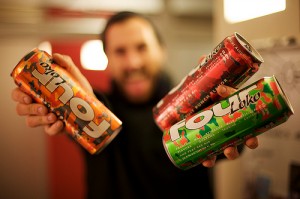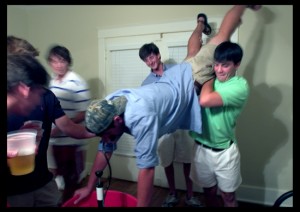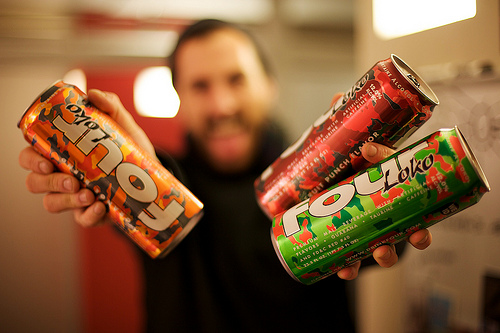The February issue of the NIAAA Spectrum, boasts that their research was used by the FDA to crack down on the makers of alcoholic energy drinks such as Four Loko. The way they present the information in this piece is instructive of the basic intellectual dishonesty which runs rampant in anti-drug/alcohol circles. With a bit of basic math, their exaggerations fall apart. Take a look at this excerpt:
Four Loko is a fruity-flavored beverage that comes in 23.5-ounce cans and is about 12 percent alcohol, meaning that each can contains the equivalent of nearly five standard alcoholic drinks.
“Essentially, this is a bottle of wine in a can—when you drink a can, you’ve just chugged a bottle of wine,” said Aaron White, Ph.D., health scientist administrator at NIAAA.
In addition, the drinks contained a large—though unspecified—amount of caffeine. Whereas a 6-ounce cup of brewed coffee has about 100 milligrams of caffeine, these alcoholic energy drinks contained 150 milligrams or more.
Notice what they’ve done here, I would say it’s like comparing apples and oranges, but even those are too similar in terms of size. This is really like comparing apples to melons. They acknowledge the reality of the size of a can of Four Loko when it fits their agenda to do so – such as when they say that it’s equivalent to a bottle of wine. But then they leave out the reality of proportions when such considerations don’t meet their agenda just a few sentences later. They portray the alcoholic energy drinks as having high caffeine content by comparing a 23.5 ounce container of Four Loko to 6 ounces of coffee! By their numbers, a cup of coffee is approximately 1/4 the size of a can of Four Loko – so if the drink was to have as much caffeine as coffee, it would really have to contain 400 milligrams of caffeine! But they’re saying it contains 150 milligrams. A fourth grader could see right through the nonsense here.
To be fair, they’re also speaking about some other drinks such as 12 ounce bottles of Moonshot (another caffeinated beer). But again, a caffeine content of 150 milligrams would put a 12 ounce drink at 75% the caffeine content of the same amount of coffee – and the portrayal in the above quote would be unfair. Reported estimates of Four Loko’s caffeine content range from 150-260mg – still far below that of coffee, even on the high end. In fact, maybe we should simply reverse the comparison, and claim that coffee is dangerous because it’s got so much higher levels of caffeine than Four Loko!
Why is this relevant to my readers? Well, it’s an example of how the powers disseminating information on drugs/alcohol, substance use, and addiction will manipulate data – right in front of your face, and assume that you’re too stupid to even notice. Unfortunately many people take the bait – these claims about Four Loko have been repeated ad nauseam in the media, and many of us believe it because we trust the experts without examining their logic or checking their facts. As a consumer of information, beware.
There are some other important distortions in the article which should be examined too, but maybe aren’t as obvious. The unstated yet clear message of the whole piece is that alcoholic energy drinks cause binge drinking and the many dangers that come along with such behavior. They don’t state this explicitly, because they know they have no such data, so instead, they strongly and fallaciously suggest it with manipulative presentation.
Studies show that people who drink nonalcoholic caffeinated energy drinks consume more alcohol when they drink than people who do not consume energy drinks. Research also indicates that college students who drink caffeinated alcoholic beverages are more likely to drink larger quantities of alcohol when they drink and to drink more often. These same students are also more likely to commit sexual assault, sustain an unintentional injury, and need medical attention.
So you see, they’re suggesting that Four Loko causes people to drink more, and more often – and it’s responsible for rape.
“There is an extremely strong association between drinking alcoholic energy drinks and serious injury,” explained Mary Claire O’Brien, M.D…..
Notice the term “association”. The proper term would have been “correlation” – but “association” allows the layman to believe that one causes the other, without explicitly stating it.
Dr. O’Brien and her colleagues found that drinkers of caffeinated alcoholic beverages “are much more likely [than drinkers of alcohol alone] to get injured enough to require medical care as a result of their drinking.”
 No doubt this is true – but there is no reason to believe that someone who drinks at safe levels would all of a sudden become a risky binge drinker because they had an energy drink. Nevertheless, this is the implication of the article and indeed all of the bad press. The underlying premise (of the whole anti-alcohol industry) is that the chemical properties of alcohol, and in this case a mixture of alcohol and caffeine, controls people and determines their behavior. This premise was deftly turned on its head by a study back in the 70’s which showed that when the taste of alcohol is masked, and people (both self-identified “alcoholics” and “social” drinkers) are told their drink doesn’t contain alcohol, they don’t drink as much as when they’re told that the drink does contain alcohol. In fact, whether the drink contains alcohol or not, they’ll still drink twice as much – if you tell them that it contains alcohol. So it isn’t the properties of the drink that determine behavior, it’s what the drinker expects to get out of it which determines their behavior.
No doubt this is true – but there is no reason to believe that someone who drinks at safe levels would all of a sudden become a risky binge drinker because they had an energy drink. Nevertheless, this is the implication of the article and indeed all of the bad press. The underlying premise (of the whole anti-alcohol industry) is that the chemical properties of alcohol, and in this case a mixture of alcohol and caffeine, controls people and determines their behavior. This premise was deftly turned on its head by a study back in the 70’s which showed that when the taste of alcohol is masked, and people (both self-identified “alcoholics” and “social” drinkers) are told their drink doesn’t contain alcohol, they don’t drink as much as when they’re told that the drink does contain alcohol. In fact, whether the drink contains alcohol or not, they’ll still drink twice as much – if you tell them that it contains alcohol. So it isn’t the properties of the drink that determine behavior, it’s what the drinker expects to get out of it which determines their behavior.
Now what is it that drinkers of Four Loko and other alcoholic energy drinks expect? Obviously, they expect to get drunk and get some energy which will allow them to drink and party longer. This is a reality, and people who want this, will find it, whether through an energy drink or some other means. They will get drunk, and party for a long time. The question though as it relates to the demonization of Four Loko, is whether the drink causes people to drink heavier and longer, or whether people who want to drink heavier and longer simply seek out a product like Four Loko. Basically, my opinion is that there is a correlation between binge drinking and people who drink alcoholic energy drinks. However, contrary to all the news reports, there is no evidence to suggest a causal relationship between alcoholic energy drinks and binge drinking – that is, energy drinks don’t cause binge drinking; people don’t lose control of their behavior after consuming an energy drink – they do what they want, expect, and choose to do.
The article links to the NIAAA’s own research on alcoholic mixed energy drinks (referred to as AmED) as used among college students, and here’s what they have to say in the abstract:
Students who were male, white, intramural athletes, fraternity or sorority members or pledges, and younger were significantly more likely to consume AmED. In multivariable analyses, consumption of AmED was associated with increased heavy episodic drinking (6.4 days vs. 3.4 days on average; p < 0.001) and twice as many episodes of weekly drunkenness (1.4 days/week vs. 0.73 days/week; p < 0.001).Students who reported consuming AmED had significantly higher prevalence of alcohol-related consequences, including being taken advantage of sexually, taking advantage of another sexually, riding with an intoxicated driver, being physically hurt or injured, and requiring medical treatment (p < 0.05).
 So in other words – fratboys and sorority girls were more likely to drink this stuff. The group of college students universally known for binge drinking, physically abusing each other, getting into hazy sexual experiences bordering on rape, and having all sorts of alcohol related incidents are the ones upon which we’re hanging the claim that alcoholic energy drinks cause binge drinking and it’s attendant negative consequences? Wow.
So in other words – fratboys and sorority girls were more likely to drink this stuff. The group of college students universally known for binge drinking, physically abusing each other, getting into hazy sexual experiences bordering on rape, and having all sorts of alcohol related incidents are the ones upon which we’re hanging the claim that alcoholic energy drinks cause binge drinking and it’s attendant negative consequences? Wow.
Again, we see the term “associated” in this passage, but I’d like to point out that the causal relationship is most likely the reverse of what’s been suggested. People who already choose to engage in binge drinking and other risky behaviors are choosing energy drinks themselves. The drinks aren’t choosing their behavior for them.
What’s more, the study reveals some other telling information:
The average age of first drink was younger among students who reported consuming AmED (15.1 years vs. 16.0 years; p < 0.001). Students who reported consuming AmED had more drinking days on average during their last year of high school than those who did not report consuming AmED (1.7 days vs. 1.2 days; p < 0.001).
So the ones who used alcoholic energy drinks are people who started drinking a year earlier than those who only drank alcohol. A year is a very significant difference when talking about teenage initiation of alcohol use. Often, those who start earlier end up abusing substances at a much higher rate than those who start later in life. Also, we see that these people also drank more often while in high school (about 40% more often). So we’re not only seeing a significant demographic difference here, we’re seeing that they have a much more substantial drinking history than those students who aren’t bingeing on alcoholic energy drinks and getting into trouble.
There is nothing new about mixing alcohol with caffeine – have you ever heard of drinks such as rum and coke, jack and coke, red bull and vodka, or irish coffee? Four Loko and others just offered a premixed alcoholic energy drink. Ultimately, these alcoholic energy drinks have been demonized because they attracted attention within the media and from young people. The banning of these drinks will not stop people from using caffein with alcohol, it will not reduce binge drinking, or date rape, or any such thing. The only thing it accomplishes is to keep the regulators busy making them look like they’re helping society, and fit nicely into the agenda of those who promote the idea that addiction/substance abuse is determined by something other than people’s personal choices. It’s a good lesson in deliberate distortion though.

I remember when the “scandalous” story came out that a state senator drank two four lokos in an hour and threw up. It was big news. It’s sad how often studies take obvious correlations and spin them into causes and effects. Once a girl tried to girl herself by ODing on lithium orotate, and an article on the effects it had on her body attributed the girl’s near-death to the availability of dangerous unregulated health supplements that don’t have “adequate studies” proving their safety. I can take or leave Four Loko but ever since all this bullshit I’ve very badly wanted it to stick around.
Anyway, it’s good to know that this article’s out there, explaining the concept of cause and effect to those of us who have been tricked into missing the obvious.